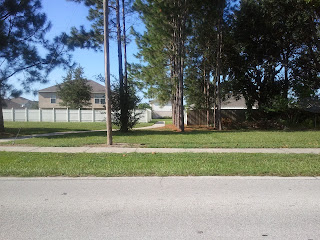One of the most difficult issues with suburban walking is the dreaded subdivision wall. It makes any walking task a real chore. The answer is to add pedestrian walkways through the wall at a walkable scale, but that means setting up walkways between houses--which is not likely to go over well for buyer or owner. As I was driving around the other day, I saw one such walkway and I love the way the homeowners handled it. Here's the view from the residential side:
From the community side it's just as cool--inviting, yet subtle:
The trees add some shade and point the way to the walkway. I might have preferred the trees on both sides of the sidewalk, but it's hard to be picky when someone finally gets it right.
I don't know the history of this connection, but it appears that both fences were constructed by the homeowners for their individual lot, though at first I wasn't sure whether those were private fences or communty fences. That brings up an important point: This is easy to do for a developer. All he would need to do is extend the community fence along both sides of the walkway. This is an area that is close to a walkable downtown area and within the local school's walk-zone. I'm sure this pathway gets used regularly by more than just school children walking to school.

